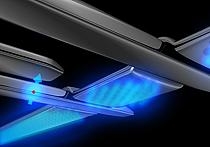Breakthrough in quantum computing
A team led by UNSW engineers and physicists has achieved a breakthrough that brings a super-fast quantum computer a step closer to reality.
A team led by UNSW engineers and physicists has achieved a breakthrough that brings a super-fast quantum computer a step closer to reality.

A team led by UNSW engineers and physicists has achieved a breakthrough that brings a super-fast quantum computer a step closer to reality by developing a "single electron reader" - a key building block in creating a silicon-based quantum machine.
Quantum computers promise exponential increases in processing speed over today's computers through their use of the "spin", or magnetic orientation, of individual electrons to represent data in their calculations.
In order to employ electron spin, the quantum computer needs both a way of changing the spin state (the "write" function) and of measuring that change (the "read" function) to form a qubit - the equivalent of the bits in a conventional computer.
In creating the single electron reader, the team led by Dr Andrea Morello and Professor Andrew Dzurak, of the School of Electrical Engineering and Telecommunications at UNSW, has made possible the measurement of the spin of one electron in silicon in a single shot experiment. The team also includes researchers from the University of Melbourne and Aalto University in Finland.
"Our device detects the spin state of a single electron in a single phosphorus atom implanted in a block of silicon. The spin state of the electron controls the flow of electrons in a nearby circuit," said Dr Morello, the lead author of the paper, Single-shot readout of an electron spin in silicon, which has been published in the journal Nature.
"Until this experiment, no-one had actually measured the spin of a single electron in silicon in a single-shot experiment."
Professor Dzurak said quantum computers will be able to perform certain tasks much faster than normal computers.
"These are tasks such as searching databases, modelling complex molecules or developing new drugs. They could also crack most modern forms of encryption," he said.
"After a decade of work trying to build this type of single atom qubit device, this is a very special moment."
Caption for graphic image (above): Artist's impression of a phosphorus atom (red sphere surrounded by a blue electron cloud, with spin) coupled to a silicon single-electron transistor, to achieve single-shot readout of the phosphorus electron spin. Credit: William Algar-Chuklin, College of Fine Arts, UNSW
Read the full release on the Faculty of Engineering website
Related links:ARC Centre of Excellence for Quantum Computer Technology
Media contacts
Dr Andrea Morello | +61 (0)2 9385 4972 | a.morello@unsw.edu.au
Professor Andrew Dzurak | +61 (0)2 9385 6311 | a.dzurak@unsw.edu.au
Peter Trute, UNSW Media Office | + 61 2 9385 1933 | 0410 271 826 | p.trute@unsw.edu.au